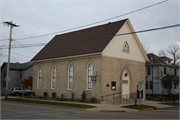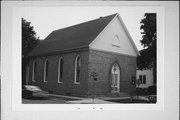Property Record
232 N PERKINS BLVD
Architecture and History Inventory
| Historic Name: | CROSS EVANGELICAL LUTHERAN CHURCH |
|---|---|
| Other Name: | BURLINGTON HISTORICAL SOCIETY MUSEUM |
| Contributing: | |
| Reference Number: | 10659 |
| Location (Address): | 232 N PERKINS BLVD |
|---|---|
| County: | Racine |
| City: | Burlington |
| Township/Village: | |
| Unincorporated Community: | |
| Town: | |
| Range: | |
| Direction: | |
| Section: | |
| Quarter Section: | |
| Quarter/Quarter Section: |
| Year Built: | 1883 |
|---|---|
| Additions: | |
| Survey Date: | 19752011 |
| Historic Use: | house of worship |
| Architectural Style: | Early Gothic Revival |
| Structural System: | |
| Wall Material: | Brick |
| Architect: | |
| Other Buildings On Site: | |
| Demolished?: | No |
| Demolished Date: |
| National/State Register Listing Name: | Not listed |
|---|---|
| National Register Listing Date: | |
| State Register Listing Date: |
| Additional Information: | POINTED ARCHED WINDOWS AND ENTRY. WOOD SHINGLES IN GABLE. A group known as the German Evangelical Lutheran Society withdrew from St. John Evangelical Lutheran Church in 1883. Plans were laid out at once for construction of a new church on land purchased for $1,000 at the corner of Perkins Boulevard and Jefferson Street. A stone house at that location was used as a parsonage. The church at 232 N. Perkins Boulevard was completed that fall and the congregation became known as Holy Cross Lutheran Church. During the fall of 1889, the church’s steeple was destroyed by lighting and soon replaced. The following year, a new bell was installed. While originally a German-speaking congregation, there was a gradually increasing demand for more English preaching until eventually German services were eliminated. By 1939, Holy Cross began using the church strictly for Sunday school classes when the former Luther Hall had been converted into a new sanctuary. After this, the original Holy Cross church building was then referred to as Luther Hall. Holy Cross acquired the former Burlington Free Church in 1923 and renovated it, including a new basement in 1928. Used to house Sunday school and organization meetings, it became known as Luther Hall. A larger worship space was needed by 1939, so Holy Cross renovated the building back into a sanctuary and began holding its services there. The exterior was extensively renovated, including cladding the exterior in stucco and constructing a Colonial Revival style steeple and entrance tower that housed a bell cast in Germany. At this time, the old Holy Cross Lutheran Church was then referred to as Luther Hall. As a plan for future growth in 1947, the congregation purchased the house immediately east of the church at 108 E. Jefferson Street to be used as a parsonage and eventually as Sunday school rooms. The Sunday school renovations were completed in 1950 and that building became known to the congregation as the Annex. It became clear that a permanent building planning committee was needed for Holy Cross Lutheran Church, and one was organized in 1955. Five years later, the congregation decided to relocate to another site rather than expanding their facilities at Kane and Jefferson Streets, which were subsequently sold. In 1959, Holy Cross purchased 5 acres of land on the east side of the city. The following year a new church was designed by the architectural firm Stade & Associates of Park Ridge, Illinois; construction began in 1962 and was completed within one year. The congregation was renamed Cross Evangelical Lutheran Church. Cross Evangelical Lutheran Church is located at 126 Chapel Terrace. The German-cast bell from the Jefferson Street church was reinstalled in the new building in 1974. The Burlington Historical Society was organized in 1928 by a group of residents interested in preserving the area’s history. Initial meetings were held in the city hall. After accumulating donations, the society required permanent space to exhibit its collection of historic articles. Three rooms in the non-extant Conkey School were soon obtained for the society’s first museum. In 1947, the collection was moved to the school’s attic and kept there for thirteen years. The former Holy Cross Lutheran Church was donated to the society for use as a museum in 1964. Since that time, the society has erected several historical markers throughout the Burlington area, including a one at the location of the historic Mormon settlement Voree, a monument in honor of Dr. Edward Galusha Dyer at Lincoln School, and a marker at the site of the first wooden frame house in Burlington. Dr. Edward Galusha Dyer was an ardent abolitionist and "commander-in-chief" of the Underground Railroad in Burlington. The original monument was donated to Burlington by Mrs. Charles Dyer Norton, wife of Dr. Dyer's grandson, in 1935. It was created by Tom Jones, who also created the Tomb of the Unknown Soldier of WWI at Arlington National Cemetery, and the Dyer monument was hewn from the same stone. Mrs. Norton, whose maiden name was Katherine McKim Garrison, was the granddaughter of two well-known abolitionists, William Lloyd Garrison and James Miller McKim. Garrison published The Liberator, a leading Eastern abolitionist newspaper. McKim and his wife accompanied Mrs. John Brown to Harper's Ferry, Virginia, in December 1859 to claim her husband's body following Brown's October 1859 raid and his subsequent trial and hanging. |
|---|---|
| Bibliographic References: | General Files. On file at the Burlington Historical Society, Burlington, Wisconsin. Bur Spur of Wisconsin's Underground Railroad brochure. |
| Wisconsin Architecture and History Inventory, State Historic Preservation Office, Wisconsin Historical Society, Madison, Wisconsin |


